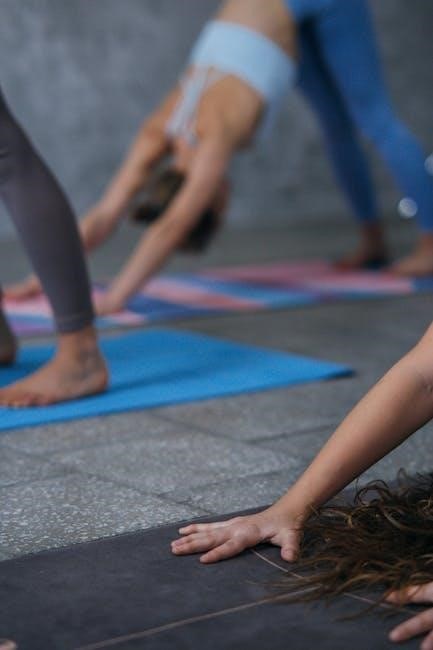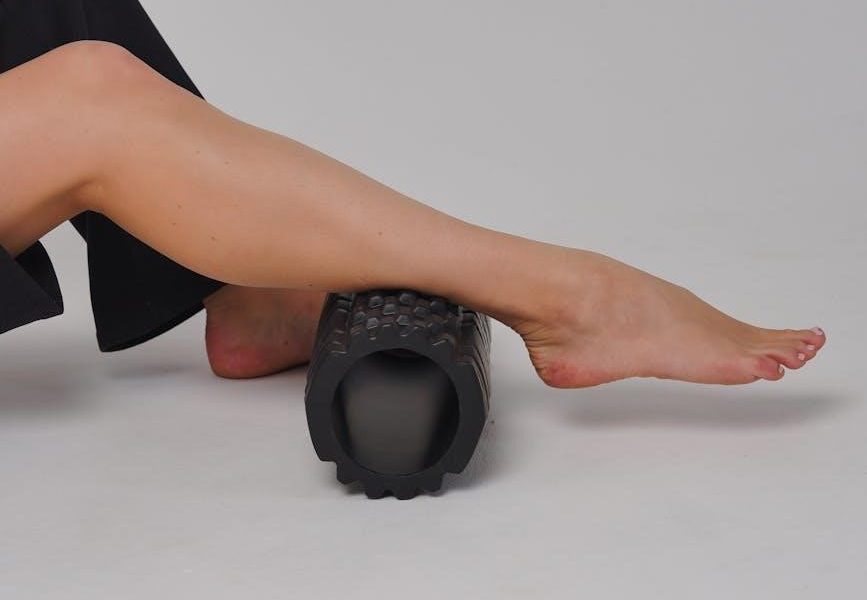Hamstring stretches are essential for improving flexibility, preventing injuries, and alleviating lower back pain. Techniques include standing, seated, and lying down stretches, often using props like towels or resistance bands. Regular stretching enhances athletic performance and overall muscle balance.
1.1 Importance of Hamstring Flexibility
Hamstring flexibility is crucial for maintaining proper posture, reducing muscle tension, and preventing injuries. Tight hamstrings can lead to lower back pain and limited mobility. Regular stretching enhances blood flow, improves range of motion, and supports overall athletic performance. Increased flexibility also reduces the risk of hamstring strains and pulls, making daily activities and sports safer and more efficient.
1.2 Benefits of Regular Hamstring Stretching
Regular hamstring stretching reduces injury risk, enhances athletic performance, and alleviates lower back pain. Improved flexibility boosts mobility, making daily activities and sports safer. Stretching increases blood flow, reduces muscle tension, and enhances range of motion. Consistent practice strengthens hamstring muscles, preventing strains and pulls, while also promoting better posture and overall muscle balance for long-term health and wellness.
1.3 Common Causes of Tight Hamstrings
Tight hamstrings often result from physical inactivity, overuse in sports, or sudden muscle contractions. Prolonged sitting, muscle imbalances, and poor posture also contribute. Additionally, inadequate stretching after workouts, direct muscle strain, or previous injuries can lead to tightness. Addressing these causes through targeted exercises and consistent stretching helps restore flexibility and prevent further discomfort or injury.
Standing Hamstring Stretches
Standing hamstring stretches effectively target the back of the legs, improving flexibility and posture. Techniques include bending forward at the hips, using a towel for support, or leaning against a wall for stability and enhanced stretch.
2.1 Standing Hamstring Stretch Technique
The standing hamstring stretch is performed by bending forward at the hips, keeping knees slightly bent, and reaching toward the toes. Hold for 20-30 seconds, maintaining a straight back. This stretch targets the hamstrings, calves, and lower back, enhancing flexibility and reducing muscle tension. Proper form is essential to avoid injury and maximize benefits. Regular practice improves posture and movement range.
2.2 Standing Hamstring Stretch with Towel
Stand with feet shoulder-width apart, loop a towel under one foot, and gently pull upward to create a stretch in the hamstrings. Keep knees straight, hold for 20-30 seconds, and breathe deeply. Switch legs and repeat. This technique enhances flexibility and reduces muscle tension without strain, making it ideal for those who prefer a gentle, controlled stretch. Proper form ensures effectiveness and safety.
2.3 Standing Hamstring Stretch Against a Wall
Stand facing a wall, hands on it for support. Extend one leg behind, heel on the ground, knee straight. Bend the front knee slightly to stretch the back leg’s hamstrings. Hold for 20-30 seconds, then switch legs. Keep the back leg straight and hips aligned to maximize the stretch. This method is effective for improving flexibility and reducing muscle tension while maintaining balance and control throughout the movement.

Seated Hamstring Stretches
Seated hamstring stretches target the muscles while sitting, often using floors, straps, or towels. They enhance flexibility, reduce tightness, and are ideal for post-workout recovery or daily routines.
3.1 Seated Hamstring Stretch on the Floor
Sit on the floor with legs extended straight. Loop a towel or strap around the ball of one foot. Gently pull the towel to lift your leg, keeping your knee slightly bent. Hold for 30 seconds to feel the stretch in the back of your thigh. Repeat on both sides to improve flexibility and reduce muscle tension effectively.
3.2 Seated Hamstring Stretch Using a Strap
Sit on the floor with legs straight, loop a strap around one foot, and gently pull to lift your leg. Keep your back straight and engage your core. Hold for 30 seconds to stretch the hamstrings deeply. Repeat on both sides. This method is ideal for those needing assistance to maintain proper form and achieve a effective stretch without straining.
3.3 Seated Hamstring Stretch with Bent Knees
Sit on the floor with knees slightly bent and feet flat. Lean forward gently, reaching for your shins or toes, while keeping your chest upright. This position allows for a controlled stretch, especially for those with tight hamstrings. Hold for 20-30 seconds, breathing deeply, to promote relaxation and flexibility without discomfort. Modify the bend in your knees to adjust the intensity of the stretch.

Lying Down Hamstring Stretches
Lying down stretches target the hamstrings effectively, using props like straps or towels for deeper relaxation. These exercises are ideal for post-workout recovery and improving flexibility.
4.1 Supine Hamstring Stretch with Strap
Lie on your back with legs straight, loop a strap around one foot, and gently pull your leg toward your chest. Hold for 30 seconds to stretch the hamstrings deeply. This stretch improves flexibility and relieves tension. Use slow movements to avoid discomfort. Perform 2-3 sets daily for optimal results. Ideal for post-workout recovery and enhancing muscle relaxation.
4.2 Lying Hamstring Stretch with Towel
Lie on your back with legs straight. Loop a towel over your foot and gently pull your leg upward, keeping your knee straight. Hold for 30 seconds to stretch the hamstrings effectively. This stretch is ideal for improving flexibility and relieving tightness. Perform 2-3 sets daily for consistent results. Modify by bending your knees slightly if needed, ensuring a comfortable yet effective stretch.
4.3 Lying Hamstring Stretch with Resistance Band
Lie on your back with legs extended. Attach a resistance band to a stable object and loop it around your foot. Slowly pull your leg toward you, keeping your knee straight, until a gentle stretch is felt. Hold for 20-30 seconds, then release. Repeat 2-3 times on each leg. This stretch enhances flexibility and strengthens the hamstrings using controlled resistance.

Hamstring Stretches Using Props
Enhance flexibility with props like foam rollers, resistance bands, or towels. These tools provide support and deepen stretches, making hamstring exercises more effective and accessible for all levels.
5.1 Hamstring Stretch with Foam Roller
Place the affected leg on a foam roller, rolling gently from the knee to the buttocks. Focus on tender areas, spending extra time for relief. Move slowly, ensuring deep tissue release. This method enhances circulation, reduces muscle tension, and improves flexibility without strain. Ideal for post-workout recovery or as part of a daily stretching routine to maintain hamstring health and mobility.
5.2 Hamstring Stretch with Resistance Bands
Sit on the floor with legs extended. Loop a resistance band around one foot, holding the ends in your hands. Gently pull the band to create tension, stretching the back of your leg. Hold for 20-30 seconds, then release. Repeat 2-3 times on each side. This stretch enhances flexibility and strengthens the hamstrings, ideal for improving mobility and reducing muscle tightness effectively.
5.3 Hamstring Stretch Using a Chair
Sit on a chair with your legs extended straight in front of you. Place one heel on the floor and keep the knee straight. Lean forward slightly from your hips until you feel a stretch in the back of your leg. Hold for 20-30 seconds and repeat 2-3 times on each side. This stretch is ideal for improving flexibility and can be done anywhere with a chair available.

Dynamic Hamstring Stretches
Dynamic stretches involve active movements to prepare hamstrings for exercise. Techniques like high knees, leg swings, and lunges improve mobility and reduce injury risk. Perform 3 sets of 10-15 reps.
6.1 High Knees for Hamstring Mobility
High knees are an effective dynamic stretch for improving hamstring mobility. Stand tall, bring one knee toward your chest, and quickly switch legs. This mimics running motion, enhancing flexibility and reducing stiffness. Perform 3 sets of 20-30 seconds. Focus on quick, controlled movements to engage the hamstrings fully. This exercise is ideal for warm-ups before running or sports, promoting better range of motion and injury prevention.
6.2 Leg Swings for Hamstring Activation
Leg swings are a dynamic stretch that activates the hamstrings while improving flexibility. Stand with feet hip-width apart and swing one leg forward and backward, then switch. Perform 2 sets of 15-20 swings per leg. This exercise enhances blood flow and reduces muscle tension, preparing the hamstrings for physical activity. It’s an excellent addition to any warm-up routine for runners and athletes, promoting better mobility and reducing injury risk.
6.3 Lunges for Dynamic Hamstring Stretch
Lunges are an effective dynamic stretch for hamstring activation. Perform walking or stationary lunges, lowering your body until your back knee nearly touches the ground. Push back up and alternate legs. Hold each stretch for 2-3 seconds and repeat for 10-15 reps per leg. This exercise improves flexibility, balance, and strength, while reducing injury risk for athletes and runners.

Hamstring Stretching for Injury Prevention
Hamstring stretching is crucial for injury prevention, utilizing methods like towel stretches or resistance bands to reduce muscle tightness, enhance flexibility, and lower strain risk, promoting overall muscle balance.
7.1 Hamstring Strain Prevention Techniques
Preventing hamstring strains involves consistent stretching routines, strengthening exercises, and proper warm-up techniques. Dynamic stretches like leg swings and high knees improve flexibility and prepare muscles for activity. Static stretches, such as seated or lying hamstring stretches, help lengthen the muscles after exercise. Incorporating resistance training and focusing on proper posture can also reduce strain risk.
7.2 Stretching to Reduce Risk of Hamstring Injuries
Regular stretching is crucial for reducing the risk of hamstring injuries. Techniques like standing, seated, and lying down stretches improve flexibility and strength. Using tools such as towels or resistance bands can enhance the stretch. Daily stretching for 30-45 seconds per muscle group helps maintain flexibility and reduces muscle tension, lowering injury risk during physical activity or sports. Consistency is key for long-term benefits.
7.3 Post-Workout Hamstring Stretching Routine
A post-workout hamstring stretching routine is vital for muscle recovery and flexibility. Begin with standing stretches, holding each for 30 seconds. Transition to seated stretches using a strap or towel to deepen the stretch. Finish with lying down stretches, such as the supine hamstring stretch with a strap, to target the entire muscle group. Perform 2-3 sets daily to reduce muscle tension and prevent soreness. Consistency enhances long-term flexibility and injury prevention.

Hamstring Stretching for Lower Back Pain
Hamstring stretching reduces muscle tightness and tension in the lower back, promoting relaxation and improving posture. Regular practice alleviates discomfort and enhances overall spinal flexibility.
8.1 Link Between Hamstring Tightness and Lower Back Pain
Tight hamstrings can pull the pelvis out of alignment, straining the lower back. This misalignment increases muscle tension, leading to discomfort and pain. Stretching the hamstrings reduces this tension, improving posture and alleviating lower back strain. Regular stretching helps maintain proper pelvic alignment, reducing the risk of lower back pain associated with tight hamstrings.
8.2 Stretching to Alleviate Lower Back Tension
Gentle hamstring stretches can significantly reduce lower back tension by relieving muscle tightness. Techniques like seated stretches or using a towel to deepen the stretch target the hamstrings, promoting relaxation. Regular practice improves posture and reduces strain on the lower back, offering long-term relief from discomfort and enhancing overall spinal flexibility and comfort.
8.3 Combined Hamstring and Lower Back Stretching Routine
A combined routine targets both hamstrings and lower back muscles, enhancing flexibility and reducing tension. Start with seated hamstring stretches, then transition to gentle cat-cow stretches for the spine. Finish with a supine hamstring stretch using a towel for deeper relaxation. This holistic approach improves posture, reduces muscle tension, and alleviates discomfort. Perform 2-3 times daily for optimal results and long-term relief.

Hamstring Stretching for Improved Performance
Regular hamstring stretching enhances athletic performance by improving flexibility, range of motion, and power. It reduces injury risk and boosts overall sports efficiency, benefiting runners and athletes.
9.1 Enhancing Athletic Performance Through Stretching
Hamstring stretching significantly boosts athletic performance by improving flexibility, power, and range of motion. It reduces muscle stiffness, enabling faster sprinting and jumping. Regular stretching also minimizes injury risks, allowing consistent training and peak performance in sports. Incorporating dynamic stretches like high knees and leg swings warms up muscles, enhancing readiness for physical activity and competition.
9.2 Stretching for Better Flexibility in Sports
Hamstring stretching is crucial for improving flexibility in sports, enabling athletes to achieve peak performance. Regular stretching enhances range of motion and reduces muscle stiffness. Techniques like towel stretches and resistance band exercises target the hamstrings effectively. These methods not only boost athletic performance but also prevent injuries, ensuring long-term flexibility and muscle balance. Incorporating such stretches into a daily routine supports overall sports success.
9.3 Hamstring Stretching for Runners and Athletes
Hamstring stretching is vital for runners and athletes to enhance performance and reduce injury risk. Techniques like towel stretches and resistance band exercises improve flexibility and strength. Regular stretching prevents tightness, promoting optimal stride length and speed. Incorporating dynamic stretches, such as leg swings and lunges, into pre- and post-workout routines ensures better mobility and endurance, making them indispensable for active individuals.

Tips for Effective Hamstring Stretching
Effective hamstring stretching involves using props like towels or resistance bands, holding stretches for 30-45 seconds, and breathing deeply. Consistency and pain-free practices ensure optimal results.
10.1 Proper Breathing Techniques During Stretching
Proper breathing during hamstring stretches enhances relaxation and flexibility. Inhale deeply before stretching, exhale slowly while extending the stretch, and maintain steady breaths to avoid muscle tension. Holding breath can increase stiffness, while synchronized breathing promotes deeper stretches and faster recovery. Consistent breathing patterns ensure a safe and effective stretching routine for optimal muscle flexibility and comfort.
10.2 Duration and Frequency of Hamstring Stretches
Hamstring stretches should be held for 20-30 seconds to allow muscle relaxation and maximize flexibility. Perform stretches 2-3 times daily for consistent progress. Regularity is key, as occasional stretching may not yield lasting results. Over time, this routine helps lengthen the hamstrings, reducing tension and improving mobility. Adjust frequency based on activity levels and fitness goals to maintain optimal muscle balance and prevent tightness.
10.3 Modifying Stretches for Different Fitness Levels
Beginners can start with gentle seated or lying stretches, using props like towels or bands for support. Intermediate levels can incorporate dynamic stretches and resistance bands. Advanced individuals may add deep stretches or plyometric movements. Modifications ensure stretches are accessible and effective for all fitness levels, promoting progress without risk of overexertion or injury.

Hamstring Stretching Routine
A well-structured routine includes daily stretches, dynamic warm-ups, and cool-down exercises. Combine standing, seated, and lying stretches for a balanced approach, adjusting intensity and duration based on fitness goals.
11.1 Morning Hamstring Stretching Routine
Begin with gentle dynamic stretches like leg swings and high knees to activate hamstrings. Transition to static stretches, such as seated stretches or towel-assisted stretches, holding each for 30 seconds. Incorporate foam roller mobilization to release tension. End with a standing hamstring stretch, bending forward at the hips. Perform 2-3 sets of each exercise, ensuring a smooth flow to enhance flexibility and prepare for the day ahead.
11.2 Evening Hamstring Stretching Routine
Conclude your day with a relaxing hamstring routine to promote recovery. Start with seated stretches on the floor or using a strap, holding each for 30 seconds. Incorporate towel-assisted stretches to deepen the stretch gently. Transition to lying down stretches with a resistance band or foam roller for added release. Finish with standing stretches against a wall to unwind. Perform 2-3 sets of each exercise to enhance flexibility and reduce muscle tension overnight.
11.3 Weekly Hamstring Stretching Schedule
A well-structured weekly plan ensures consistent progress. Begin with foundational stretches like standing and seated hamstring stretches on Monday and Wednesday. Incorporate towel-assisted stretches on Tuesday and Thursday for deeper targeting. Use foam rollers or resistance bands on Friday for enhanced release. Saturday focuses on dynamic stretches, while Sunday includes active recovery with gentle lying down stretches. Aim for 3-4 sets per exercise, holding each for 20-30 seconds. Adjust the schedule based on your fitness level and goals, ensuring at least one day of rest or light activity. Consistency is key to maintaining flexibility and preventing tightness.
Consistent hamstring stretching improves flexibility, reduces injury risk, and enhances performance. Incorporate various techniques into your routine for long-term benefits and overall muscle balance.
12.1 Summary of Key Points
Hamstring stretches enhance flexibility, reduce injury risk, and improve athletic performance. Techniques include standing, seated, and lying stretches, often using props like towels or resistance bands. Regular practice alleviates lower back pain and promotes muscle balance. Consistency is key for long-term benefits, making hamstring stretching an essential part of any fitness or rehabilitation routine.
12.2 Importance of Consistency in Hamstring Stretching
Consistency in hamstring stretching is crucial for maintaining flexibility and preventing injuries. Regular practice helps lengthen muscles over time, reducing strain on the lower back and improving overall mobility. Even brief daily sessions can yield significant benefits, making it a vital habit for athletes and individuals alike.
12.3 Final Tips for Maintaining Hamstring Flexibility
Consistency is key to maintaining hamstring flexibility. Incorporate daily stretching routines, even briefly, to prevent tightness. Use props like towels or resistance bands for deeper stretches. Focus on proper form to avoid injury and gradually increase intensity. Pair stretching with strength training for balanced muscle development. Patience and dedication will yield long-term benefits, ensuring optimal mobility and reduced risk of hamstring-related issues.
